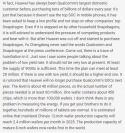Core tip: Shanghai Lizhao Technology, a key component radio frequency and plasma system supplier for semiconductor equipment, announced the completion of tens of millions of yuan in Pre-A round financing, and invited Song Wei, former general manager of Aixiang China, to join Shanghai Lizhao Technology, a supplier of RF and plasma systems, key components of semiconductor equipment, announced that it has completed tens of millions of yuan in Pre-A round financing, and invited Song Wei, former general manager of Aixtron China, to join him as vice president. This round of financing was led by SMIC, and jointly invested by Monolith Capital and Lingang Venture Capital. Founded in August 2022, Lizhao Technology is located in Minhang District, Shanghai. It is a radio frequency and plasma system supplier focusing on the field of semiconductor process equipment.
Plasma technology has been widely used, especially in the field of pan-semiconductor manufacturing processes. In addition to the wet process, the application fields of plasma almost cover from etching (Etch), atomic layer deposition (ALD/ALE), physical and chemical deposition (PVD/CVD), ion implantation (Implant), dry debonding (Strip) to lithography (Photo), and even most of the subdivided semiconductor processes of chemical mechanical polishing (CMP). The plasma generation and application system has become one of the basic subsystems of the semiconductor equipment industry. Other key subsystems include vacuum systems, flow systems, optical systems, transmission systems, and so on.
Zhao Kui, the founder of Lizhao Technology, told 36Kr that the Lizhao Technology team has a deep accumulation and a complete layout in radio frequency, power electronics, control and algorithm technology. High-frequency power electronics is a kind of radio frequency technology, and its talents are very scarce in the world. Semiconductor radio frequency power supplies require megahertz-level power electronics technology. The core members of the company have been deeply involved in research in this field since 2012, and are one of the few Chinese experts in the world.
At the same time, the algorithm of the product needs to be combined with the semiconductor process. It needs to be familiar with the plasma processing process and have a solid mathematical background. Lizhao Technology can research and optimize the algorithm according to the actual process needs of customers.
Song Wei, vice president of the company, said: "Under the background of the safety requirements of the semiconductor industry and the actual market demand, the field of radio frequency plasma needs a high-quality and efficient team of scientists with a background to break through the ceiling of domestic technology as soon as possible, challenge and eventually surpass the international market. industry leader.” Therefore, after the initial successful product development, he joined Lizhao Technology, expecting to promote Lizhao’s rapid development with his rich market application experience.
At present, the main products of Lizhao Technology are plasma RF power supply and its supporting system and remote plasma source (RPS) system, and the basic function of these products is to generate plasma in related semiconductor process equipment and achieve related various processes.
In response to these technical requirements,
the company has developed 13.56MHz series and 400KHz series RF power supply products within one year of its establishment. Some key performance parameters have reached the international advanced level, such as power adjustable accuracy of 0.1 watts, pulse frequency from 2Hz to 50KHz, accounting for The empty ratio is 1%-99%, and with the unique MOFT frequency modulation function (model-oriented automatic frequency modulation technology), it can realize sub-millisecond level high-speed impedance matching, which can effectively meet the needs of various processes, and is the first in China for advanced etching Processes such as atomic layer deposition and atomic layer deposition provide alternatives.
At the same time, in the field of remote plasma source (RPS), the company is developing a product that can be used in 12-inch wafer deglue/oxidation/cleaning and other process fields. It is expected to send samples to key customers for testing by the end of the year. The Lizhao team said that under the current complex international situation, it is urgent to fundamentally solve the overall supply chain security problem of domestic semiconductor equipment. The vision of Lizhao Technology is to create a world-class Chinese RF plasma solution enterprise relying on its own solid industrial technology background.
The founding team of Lizhao Technology comes from well-known universities and research institutions at home and abroad. It has many years of experience in the development of advanced semiconductor equipment, and more than ten years of experience in R&D and manufacturing of RF power systems. has a deep accumulation. The chief scientist, Professor Liu Ming, is a doctoral supervisor of the Department of Electrical Engineering of Shanghai Jiaotong University, and has been engaged in the research of high-frequency power electronics at Princeton University in the United States.
Song Wei, vice president of the company, is the former general manager of Aixiang in China and graduated from Beihang University. Before joining Lizhao Technology, he worked in many well-known companies in Europe and the United States, such as Varian, AMAT, MKS, Kateeva and AIXTRON. The company holds senior management positions such as general manager or sales director in China.

